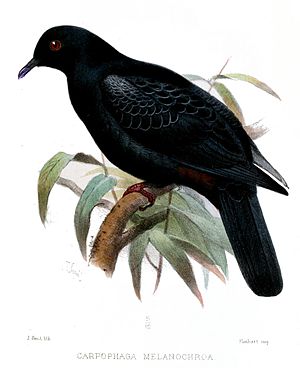Black fruit pigeon
| Black fruit pigeon | ||||||||||
|---|---|---|---|---|---|---|---|---|---|---|

Black fruit pigeon |
||||||||||
| Systematics | ||||||||||
|
||||||||||
| Scientific name | ||||||||||
| Ducula melanochroa | ||||||||||
| ( Sclater , 1878) |
The black fruit pigeon ( Ducula melanochroa ), also known as the carrot pigeon , is a type of pigeon bird that is one of the fruit pigeons . It is endemic to the Bismarck Archipelago , which politically belongs to Papua New Guinea .
The stock situation of the black-collar fruit pigeon is given as Least Concern (not endangered).
Appearance
The black fruit pigeon reaches a body length of up to 43 centimeters. It is thus somewhat larger than a wood pigeon , but has a somewhat stronger physique. The tail accounts for 13.5 to 15.2 centimeters. There is no noticeable gender dimorphism .
The wax skin of the beak is largely featherless, so that the forehead appears steep. The front of the head, the crown, the neck and the coat are black. The plumage shines on the coat. The feathers of the elytra are very narrowly lined with white floury. The back to the upper tail-coverts is black, the individual feathers are narrowly banded in slate gray, which is most noticeable on the upper-tail coverts. The tail feathers are black on the top and silvery gray on the underside.
The chin, throat, ear covers, neck, chest, flanks, thighs and stomach are black, the chest has a bluish tinge. The rump and the under tail-coverts are dark chestnut brown.
The beak is slate gray with a black tip. The iris is dark red. The legs and feet are dark wine red.
Possibility of confusion
The collar pigeon occurs in the distribution area of the black fruit pigeon. It belongs to a different genus and in direct comparison the two species cannot be confused. Collared pigeons that are not yet sexually mature appear completely black in flight and can therefore be confused with the black fruit pigeon. They differ in having longer wings, a shorter tail and a longer and thinner neck.
Distribution area and habitat
The distribution area of the black-collar fruit pigeon are the islands of the Bismarck archipelago . The main islands of the Bismarck Archipelago, to which a total of 200 islands belong, lie in a semicircle in northeast New Guinea, from which they are separated by the approximately 90 kilometers wide Dampierstrasse . The black fruit pigeon is found mainly on New Britain , Watom and the Duke of York Islands and New Ireland of the archipelago. The black fruit pigeon also inhabits the island of Umboi , which is located in the Dampierstrasse.
The black fruit pigeon occurs on these islands mainly in primary forests and on forest fringes. It prefers mountain forests above 500 meters and occurs in New Britain up to 1850 meters above sea level. On Umboi, it is found at altitudes between 300 and 700 meters.
Way of life
The black fruit pigeon lives solitary, in pairs and in small groups. Occasionally, up to 20 pigeons gather in individual trees.
Black fruit pigeons look for their food mainly in the upper treetop area. They eat fruits with a diameter of 1.5 to 3.5 centimeters. It has not yet been finally clarified whether the black fruit pigeon migrates nomadically or undertakes seasonal migrations. Since they occasionally occur on smaller islands that lie between New Britain and New Ireland, it is assumed that black fruit pigeons migrate between these two islands.
The breeding biology of this species has not yet been conclusively investigated. So far a nest has only been found in New Ireland.
literature
- David Gibbs, Eustace Barnes and John Cox: Pigeons and Doves - A Guide to the Pigeons and Doves of the World . Pica Press, Sussex 2001, ISBN 90-74345-26-3 .
- Gerhard Rösler: The wild pigeons of the earth - free living, keeping and breeding . M. & H. Schaper Verlag, Alfeld-Hannover 1996, ISBN 3-7944-0184-0 .
Web links
- Ducula melanochroa in the endangered Red List species the IUCN 2009. Posted by: BirdLife International, 2009. Retrieved on November 5 2016th
- Call of the black fruit dove on Xeno-Canto
Individual evidence
- ↑ a b Ducula melanochroa in the endangered Red List species the IUCN 2009. Posted by: BirdLife International, 2009. Retrieved on November 4 2016th
- ^ Gibbs, Barnes and Cox: Pigeons and Doves , p. 561.
- ↑ a b c Gibbs, Barnes and Cox: Pigeons and Doves , p. 560.
- ↑ Rösler: The wild pigeons of the earth , p. 305.